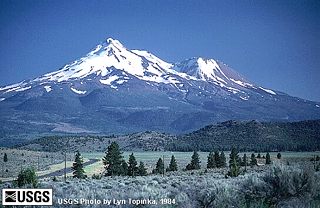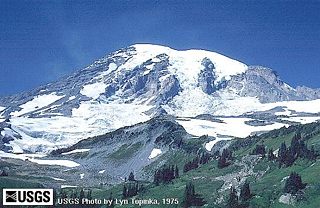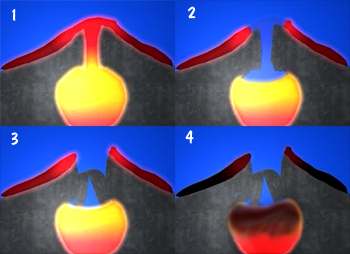Stratovolcanoes are the "big ones", they exist for and are active for long periods of time. They have dual behavior and produce smooth magma flows and eject tephra from time to time. As a result they have a profile somewhat like both tephra volcanoes and shield volcanoes. Fundamentally they are a shield volcano with a tephra volcano buried inside and rising around the highest part of the vent.
Since they produce both types of flows, the more fluid magma welds together the tephra and maintains a strong base for growth. They are far more erosion resistant than tephra volcanoes and thus grow to enormous size. Mt. Fuji, Mt. Rainer, and Mt. Baker are all stratovolcanoes.
 |
 |
| Mt. Shasta, Ca. | Mt. Rainer, Wa. |
| Images: U.S. Department of Interior, U.S. Geological Survey | |
Caldera: a larger than normal crater like structure in the top of a volcano. It is due to the partial collapse of the volcano top after a large eruption. In some eruptions the lava cavity below the vent depletes a portion of itself and forms an empty chamber. The over hanging ground can collapse under its own weight. It falls into the still partially full magma chamber and creates a large circular opening at the top.
This is what happened at crater lake where the caldera is now filled by water. This only happens on large volcanoes were there is substantial weight above the magma center.

Lava Dome: a lava dome is a final bulge of lava that uplifts a small portion in the vent area of a volcano after the eruption subsides. It act as a conduit to release the slow loss of water often associated with a post eruption.
Fissure eruptions: this happen when lava makes its way to the surface through a long crack in the ground and not through a volcano. They often produce huge amounts of lava, but usually they are not explosive.
Pillow basalts: self enclosed rock structures with glassy outsides created when undersea fissure type eruptions are chilled almost instantly by the cool sea water.

Pillow Lava
Photo: U.S. Department of Interior,
U.S. Geological Survey
Volcanic Hazards:
1.) Pyroclastic flows (fast, hot, often toxic)
2.) Tephra may bury people (toxic fumes)
3.) Tephra (smaller size) in conjunction with water can cause dangerous mud flows.
4.) Under sea eruptions ---> tsunami wave (giant tidal waves)
5.) Wipe out livestock or bury farming land causing famine.
| NEXT | TOC | PREV |